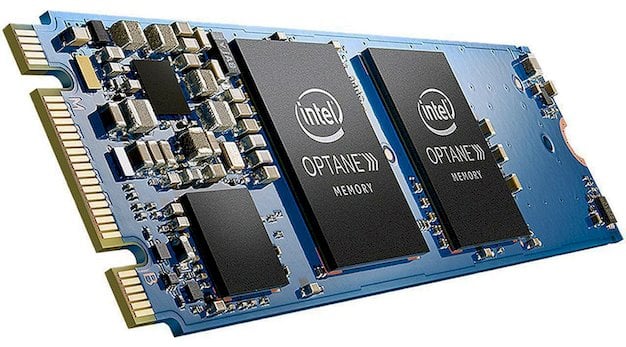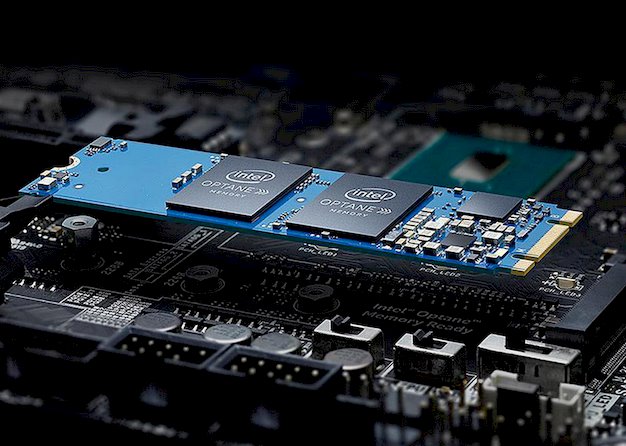Intel Optane Memory Update: Making Hard Drives Perform Like Fast SSDs
Intel Optane Memory - Updates And Overview
When Intel initially released its Optane Memory line-up, it was one of the most potent and effective storage acceleration products available, right out of the gate. Due to its 3D Xpoint memory technology, which enables consistent, low-latency, high-speed data transfers at low-queue depths, Intel’s Optane Memory is ideally suited for caching smaller chunks of data in consumer systems. Couple Optane Memory’s unique performance characteristics with Intel’s robust caching algorithms and it showcases the effectiveness of Intel’s solution with today’s PCs.
Intel has since updated its Optane Memory line-up with a 64GB drive and some new software that enables acceleration of secondary storage volumes. At first, Optane Memory could only accelerate the main OS boot volume and drives were limited to capacities of 16GB and 32GB.
Having the ability to accelerate secondary volumes opens up some interesting possibilities. Users could place their OS and most commonly used apps on a speedy SSD, for example, and accelerate a slower, secondary drive that may be filled with large amounts of bulk data. In enthusiast and gaming circles, it’s not uncommon for someone to have a multi-terabyte hard drive with a huge Steam library. Instead of shelling out big bucks for a high-capacity SSD, users with a compatible Intel system could now leverage Optane Memory and accelerate that big game library with little fuss.
Intel Smart Response Technology is a caching mechanism that uses a solid state drive – like Intel Optane Memory -- to enhance overall system performance and simplify the drive configuration presented to the end-user in the OS. The SSD can be paired to any other drive in a compatible, regardless of the capacity. Optane Memory is then used as a high-speed repository for the most commonly accessed data blocks (not necessarily complete files). Usage patterns on the drive being accelerated are monitored and the most frequently accessed bits of data are copied from it, to Optane Memory. Because the Optane Memory is used as a cache, it is not presented to the end-user as a separate volume. It works transparently in the background, which can be convenient for less-savvy users not accustomed to managing multiple storage volumes.
Like other SSD / HDD hybrid storage technologies, the data on the hard drives has to be accessed multiple times before it is accelerated and optimized. So, the contents of the SSD will dynamically and constantly change over time, based on usage patterns. The most commonly accessed data from the slower drive gets copied to the much higher performing Optane Memory, which results in a performance boost when that data needs to be fetched.
Knowing how Smart Response technology works, reveals one of the drawbacks of a hybrid setup—the Intel Optane Memory will offer little or no performance benefit to infrequently accessed or new data. So, with large file copies, application installations, and similar data, a system with Smart Response enabled may perform much like it wasn't being accelerated at all. With that said, a significant portion of the data being cached to Optane Memory when accelerating a bootable OS volume will be parts of the OS/Windows. So, although brand new data introduced to the system must be accessed more than once to be considered by the caching algo, the system will almost always seem faster and more responsive, because bits of the OS itself are cached.
The first products in Intel’s Optane Memory line-up were M.2 “gumstick” type NVMe SSDs, with capacities of 16GB and 32GB. But recently, a larger 64GB model was released. The sticks themselves look rather simple, with only one (16GB), two (32GB), or 2 higher-capacity (64GB) 3D Xpoint memory media packages populating the PCB, along with the Intel-made controller and a few other surface mounted components.
The main features and specifications of Intel’s Optane Memory products are outlined in the table above. What you’ll notice is that Optane Memory offers relatively high performance at low-queue depths, which are most common in desktop client computing workloads. Sequential read/writes for the lower capacity drives are 1.2GB/s and 280MB/s respectively, which aren’t world-beating versus many of today’s higher-end NVMe SSDs, but it is significantly faster than any hard drive, and latency with Intel Optane Memory, especially at lower queue depths, will be superior to almost all other consumer storage solutions. The 64GB drive's performance is significantly higher, however, at about 1.6GB/s+ (reads) and 600MB/s+ (writes).
Also note that Intel Optane Memory will work only on Windows 10 64-bit systems with Intel 7th or 8th Gen based processors and 200 or 300-series chipsets, or newer systems. They will not work on previous-gen Skylake-based systems, or anything older, even if it has an M.2 slot.
Intel has since updated its Optane Memory line-up with a 64GB drive and some new software that enables acceleration of secondary storage volumes. At first, Optane Memory could only accelerate the main OS boot volume and drives were limited to capacities of 16GB and 32GB.
Having the ability to accelerate secondary volumes opens up some interesting possibilities. Users could place their OS and most commonly used apps on a speedy SSD, for example, and accelerate a slower, secondary drive that may be filled with large amounts of bulk data. In enthusiast and gaming circles, it’s not uncommon for someone to have a multi-terabyte hard drive with a huge Steam library. Instead of shelling out big bucks for a high-capacity SSD, users with a compatible Intel system could now leverage Optane Memory and accelerate that big game library with little fuss.
|
| Model Name | Intel Optane Memory Series Memory |
| Capacity (GB) | 16GB, 32GB, 64GB |
| Components | Intel Optane memory module with 3D XPoint memory media Intel Controller and Firmware Intel Rapid Storage Technology 15.5 or later |
| Interface | PCIe 3.0x2 with NVMe interface |
| Form Factor | M.2 2280-S3-B-M |
| Latency (avg sequential) | Read: 6 µs (TYP) Write: 16 µs (TYP) |
| Height/Weight | Up to 1.5mm / Up to 40 grams |
| Reliability | 1.2 million hours Mean Time Between Failure (MTBF) 1 sector per 1017 bits read Uncorrectable Bit Error Rate (UBER) |
| Temperature | Operating: 0 to 70c Non-Operating: -40 to 85c |
| Performance @Queue Depth 4 | Sequential R/W: Up to 1200/280 MB/s 4KB Random R/W: Up to 300k/70k IOPS |
| Power | 3.3V Supply Rail Active: 3.5W Drive Idle: 900mW to 1.2W |
| Endurance Rating | 100GB Writes Per Day |
| Operating System Support | Windows 10 64-bit |
| Supported Platforms | 7th Gen or newer Intel Core Processor-based Platforms |
| Compliance | NVM Express 1.1 PCI Express Base Specification Rev 3.0 PCI M.2 Hardware Specifications Ecological: European Union (ED) RoHS Compliance Directives |
| Software Tools | Intel Optane Memory Software Intel Rapid Storage Technology Software Intel SSD & Memory Toolbox |
| Pricing (MSRP) | $57 (16GB), $79 (32GB), $151 (64GB) |
What Is Intel Optane Memory?
Intel Optane Memory products and their associated software are designed to cache the most frequently accessed bits of data on a drive, which can significantly increase performance and responsiveness. If that sounds familiar – it should. The implementation is very similar to Intel’s original Smart Response Technology, which debuted all the way back when the SSD 311 series of SATA-based solid state drives was released. In fact, one of the pieces of software included with Intel Optane Memory will still carry the Smart Response Technology monikerIntel Smart Response Technology is a caching mechanism that uses a solid state drive – like Intel Optane Memory -- to enhance overall system performance and simplify the drive configuration presented to the end-user in the OS. The SSD can be paired to any other drive in a compatible, regardless of the capacity. Optane Memory is then used as a high-speed repository for the most commonly accessed data blocks (not necessarily complete files). Usage patterns on the drive being accelerated are monitored and the most frequently accessed bits of data are copied from it, to Optane Memory. Because the Optane Memory is used as a cache, it is not presented to the end-user as a separate volume. It works transparently in the background, which can be convenient for less-savvy users not accustomed to managing multiple storage volumes.
Like other SSD / HDD hybrid storage technologies, the data on the hard drives has to be accessed multiple times before it is accelerated and optimized. So, the contents of the SSD will dynamically and constantly change over time, based on usage patterns. The most commonly accessed data from the slower drive gets copied to the much higher performing Optane Memory, which results in a performance boost when that data needs to be fetched.
Knowing how Smart Response technology works, reveals one of the drawbacks of a hybrid setup—the Intel Optane Memory will offer little or no performance benefit to infrequently accessed or new data. So, with large file copies, application installations, and similar data, a system with Smart Response enabled may perform much like it wasn't being accelerated at all. With that said, a significant portion of the data being cached to Optane Memory when accelerating a bootable OS volume will be parts of the OS/Windows. So, although brand new data introduced to the system must be accessed more than once to be considered by the caching algo, the system will almost always seem faster and more responsive, because bits of the OS itself are cached.
The first products in Intel’s Optane Memory line-up were M.2 “gumstick” type NVMe SSDs, with capacities of 16GB and 32GB. But recently, a larger 64GB model was released. The sticks themselves look rather simple, with only one (16GB), two (32GB), or 2 higher-capacity (64GB) 3D Xpoint memory media packages populating the PCB, along with the Intel-made controller and a few other surface mounted components.
The main features and specifications of Intel’s Optane Memory products are outlined in the table above. What you’ll notice is that Optane Memory offers relatively high performance at low-queue depths, which are most common in desktop client computing workloads. Sequential read/writes for the lower capacity drives are 1.2GB/s and 280MB/s respectively, which aren’t world-beating versus many of today’s higher-end NVMe SSDs, but it is significantly faster than any hard drive, and latency with Intel Optane Memory, especially at lower queue depths, will be superior to almost all other consumer storage solutions. The 64GB drive's performance is significantly higher, however, at about 1.6GB/s+ (reads) and 600MB/s+ (writes).
Also note that Intel Optane Memory will work only on Windows 10 64-bit systems with Intel 7th or 8th Gen based processors and 200 or 300-series chipsets, or newer systems. They will not work on previous-gen Skylake-based systems, or anything older, even if it has an M.2 slot.










